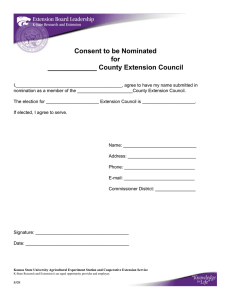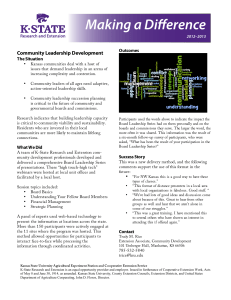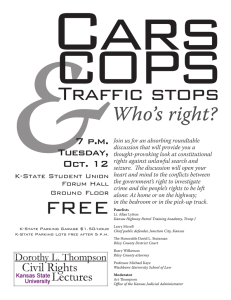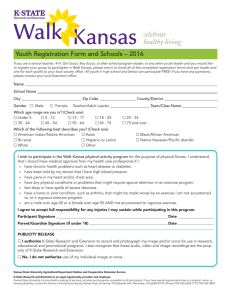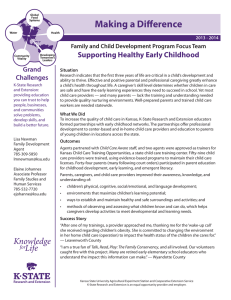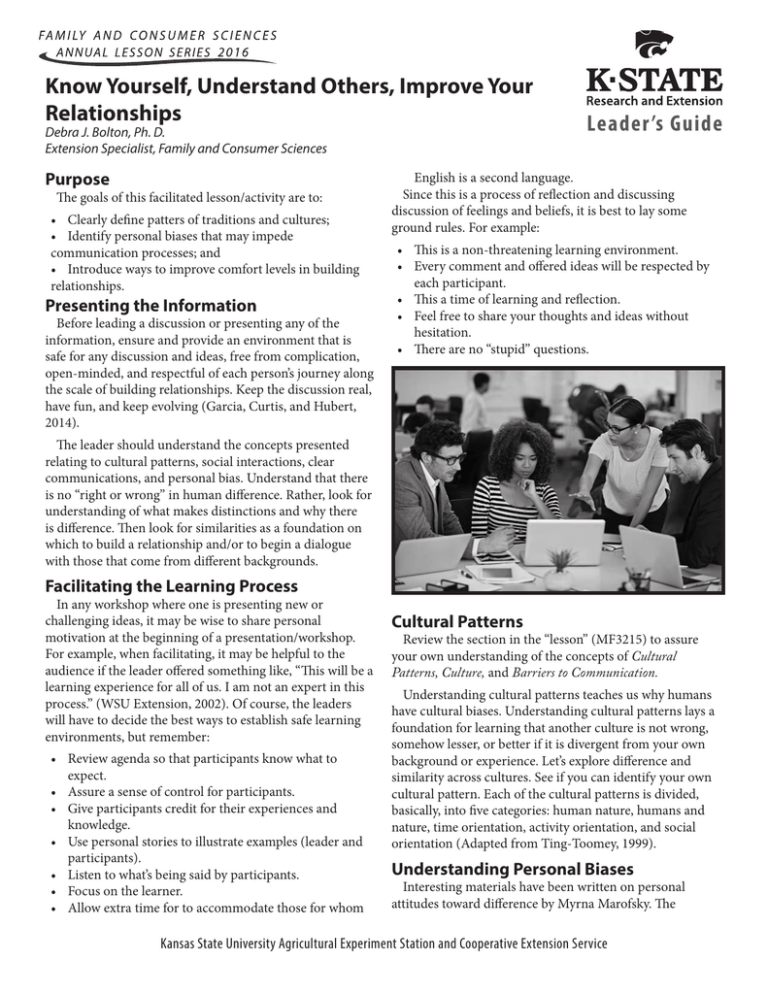
Know Yourself, Understand Others, Improve Your
Relationships
Debra J. Bolton, Ph. D.
Extension Specialist, Family and Consumer Sciences
Purpose
The goals of this facilitated lesson/activity are to:
• Clearly define patters of traditions and cultures;
• Identify personal biases that may impede
communication processes; and
• Introduce ways to improve comfort levels in building
relationships.
Presenting the Information
Before leading a discussion or presenting any of the
information, ensure and provide an environment that is
safe for any discussion and ideas, free from complication,
open-minded, and respectful of each person’s journey along
the scale of building relationships. Keep the discussion real,
have fun, and keep evolving (Garcia, Curtis, and Hubert,
2014).
Leader ’s Guide
English is a second language.
Since this is a process of reflection and discussing
discussion of feelings and beliefs, it is best to lay some
ground rules. For example:
• This is a non-threatening learning environment.
• Every comment and offered ideas will be respected by
each participant.
• This a time of learning and reflection.
• Feel free to share your thoughts and ideas without
hesitation.
• There are no “stupid” questions.
The leader should understand the concepts presented
relating to cultural patterns, social interactions, clear
communications, and personal bias. Understand that there
is no “right or wrong” in human difference. Rather, look for
understanding of what makes distinctions and why there
is difference. Then look for similarities as a foundation on
which to build a relationship and/or to begin a dialogue
with those that come from different backgrounds.
Facilitating the Learning Process
In any workshop where one is presenting new or
challenging ideas, it may be wise to share personal
motivation at the beginning of a presentation/workshop.
For example, when facilitating, it may be helpful to the
audience if the leader offered something like, “This will be a
learning experience for all of us. I am not an expert in this
process.” (WSU Extension, 2002). Of course, the leaders
will have to decide the best ways to establish safe learning
environments, but remember:
• R
eview agenda so that participants know what to
expect.
• Assure a sense of control for participants.
• Give participants credit for their experiences and
knowledge.
• Use personal stories to illustrate examples (leader and
participants).
• Listen to what’s being said by participants.
• Focus on the learner.
• Allow extra time for to accommodate those for whom
Cultural Patterns
Review the section in the “lesson” (MF3215) to assure
your own understanding of the concepts of Cultural
Patterns, Culture, and Barriers to Communication.
Understanding cultural patterns teaches us why humans
have cultural biases. Understanding cultural patterns lays a
foundation for learning that another culture is not wrong,
somehow lesser, or better if it is divergent from your own
background or experience. Let’s explore difference and
similarity across cultures. See if you can identify your own
cultural pattern. Each of the cultural patterns is divided,
basically, into five categories: human nature, humans and
nature, time orientation, activity orientation, and social
orientation (Adapted from Ting-Toomey, 1999).
Understanding Personal Biases
Interesting materials have been written on personal
attitudes toward difference by Myrna Marofsky. The
Kansas State University Agricultural Experiment Station and Cooperative Extension Service
idea of teaching anything that has to do with human
interactions must include the understanding of personal
biases. Marofsky developed the “Tolerance Scale,” in which
humans come to understand our their own attitudes toward
difference.
Appreciation: You value the difference of others and
believe that difference enhances your own life.
Acceptance: Difference does not really matter to you. You
tend to look for commonalities and try to ignore difference.
Tolerance: You don’t feel completely comfortable with
difference. You will treat those we you view as different with
respect, but you would rather not have them as associates
Avoidance: Difference clearly makes you uncomfortable.
You try to avoid and do not want to work with those who
are different.
Repulsion: Difference is not seen as “normal.” Working or
coming in contact with those who are different causes you a
lot of discomfort.
These points are not to describe a “right” or “wrong” in
being. Rather it is to promote the notion that all humans
have biases. In order to move others, as facilitators, toward
understanding barriers to building relationships, it is best to
recognize personal reasons for obstacles to trusting others
and experiencing satisfying interactions.
Fostering Relationships with Those in
Other Cultures
Activity – Group Builder/Mixer – What’s in Your
Name?
By Deryl Waldren, 4-H Youth Development Specialist*
This group-builder highlights our uniqueness by helping
participants celebrate the name origins of one another. It
offers an excellent way to begin a workshop, because it helps
each participant introduce him/herself with a personal
story, which puts most people at ease for building dialogue.
Participants will often remember the details about another
person’s name long after the training or meeting is over.
1. Pick any part of your name (first, middle, last, maiden,
etc.).
2. Write it on flip chart, white board, or someplace
conspicuous in front of the group with a marker of the
color of your choice.
3. What’s the significance of that name? Why were you
named that? What’s the story behind your name, etc.?
4. Share your commentary with the group. Larger groups
may want to have a time limit.
5. Each person will complete sharing his/her name in a
random order.
The facilitator or any observers would likely participate in
this game, too. It sets the stage for discussion and promotes
familiarity, which will aid in further discussion with
workshop materials.
* Adapted from “Name Origin” from Leadership RAP
Often, when one speaks of diversity, there are
connotations of race, ethnicity, and people of other cultural
backgrounds. That is not always true. The definition of
diverse is simply: variety, different, varied, mixed, and
distinct. Notice your own family, with whom you have
had a life-long relationship. You will find many things that
make you different from one another. You will see physical,
intellectual, beliefs, and many other differences. But do
you dwell on those differences? It’s likely that you do not,
because you have a vested interest in one another. Is it
possible to develop similar relationships with other people?
That is not definite, but better knowledge of one another
leads to greater unity in human groups (Shapiro interview,
2001).
2
K-State Research and Extension — Know Yourself, Understand Others, Improve Your Relationships — Leader’s Guide
References
Bronfenbrenner, U. (1979). The ecology of human
development. Cambridge MA: Harvard University Press.
Coleman, J.S. (1994). Foundations of social theory.
Cambridge, MA: Belnap Press.
Flora, C. B., and Flora, J. (2012). Rural Communities:
Legacies and Change. 4th Ed. Westview Press, Boulder.
Glaeser, E. (2001). The formation of social capital.
Retrieved June 12, 2010 from www.oecd.org. Paris,
France: Organization for Economic Co-– operation and
Development.
Goleman, D. (2006). Social intelligence. Bantam Dell,
New York.
Kluckhohn, F, and F. Strodtbeck. (1961). Variationsin
value orientations. New York: Row, Peterson.
Marofsky, M. (2008). The art of diversity training.
Novations, Minneapolis.
Ting-Toomey, S. and L.C. Chung. (2005). Understanding
intercultural communication. Los Angeles: Roxbury.
Deen, M.K., Husky, M., Parker, L. (2009). Navigating
Difference. Washington State University Extension, Pullman
Valdivia, C., Jeanetta, S., Flores, L. Y., Morales, A., and
Martinez, D. (2012). Latino/a Wealth and Livelihood
Strategies in Rural Midwestern Communities. Choices: The
Magazine Food, Farm, and Resource Issues. 27(1).
K-State Research and Extension — Know Yourself, Understand Others, Improve Your Relationships — Leader’s Guide
3
Publications from Kansas State University are available at:
www.ksre.ksu.edu
Kansas State University Agricultural Experiment Station and
Cooperative Extension Service
Publications are reviewed or revised annually by appropriate faculty to
reflect current research and practice. Date shown is that of publication
or last revision. Contents of this publication may be freely reproduced
for educational purposes. All other rights reserved. In each case, credit
Dr. Debra J Bolton, Know Yourself, Understand Other, Improve Your
Relationships, Leader’s Guide, Kansas State University, July 2015.
K-State Research and Extension is an equal opportunity provider and
employer. Issued in furtherance of Cooperative Extension Work, Acts of
May 8 and June 30, 1914, as amended. Kansas State University, County
Extension Councils, Extension Districts, and United States Department
of Agriculture Cooperating, John D. Floros, Director.
MF3216 July 2015

